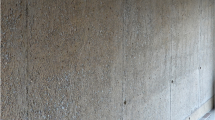Abstract
Calcium sulfate, commonly known as natural gypsum, is found in nature in different forms, mainly as the dihydrate (CaSO4 · 2H2O) and anhydrite (CaSO4). They are products of partial or total evaporation of inland seas and lakes. Both the dihydrate and the anhydrite occur in nature in a variety of forms. The origin of gypsum, its genesis, varieties and properties are discussed, and the focus is then on the most common binding material produced from it, plaster of Paris (β-hemihydrate), known in France as ‘plâtre de Paris’, in the USA as ‘calcined gypsum’, and in Germany as ‘Stuckgips’. Details are given of the properties of gypsum paste (setting, expansion, and adhesion) and of hardened gypsum (strength, bulk weight, thermal expansion, volume and linear changes under humidity fluctuations, moisture absorption, paintability, corrosivity, thermal and acoustic insulation behaviour, and fire resistance).
Resume
Le sulfate de calcium, généralement appelé gypse naturel, se trouve dans la nature sous différentes formes, souvent comme dihydrate (CaSO4 · 2H2O) et comme anhydrite (CaSO4), qui sont le résultat d'une évaporation totale ou partielle de mers intérieures et de lacs. Aussi bien l'anhydrite que le dihydrate existent dans la nature sous une variété de formes.
Après un compte-rendu sur l'origine du gypse, sa genèse, ses variétés et propriétés, l'article traite de la matière la plus couramment produite à partir du gypse, qui est connue en France sous le nom de ‘plâtre de Paris’ (β-semi-hydrate), aux USA sous celui de ‘calcined gypsum’, et en Allemagne sous celui de ‘Stuckgips’.
L'article décrit aussi en détail les propriétés de la pâte de plâtre (prise, dilatation, adhérence) et celles du plâtre dur (résistance, poids, dilatation thermique, volume et changements linéaires sous l'influence des fluctuations de l'humidité, absorption d'eau, aptitude à être peint, corrosion, comportement à l'isolation thermique et acoustique et résistance au feu).
Similar content being viewed by others
References
Schwiete, H. E. and Knauf, A. N., ‘Alte u. neue Erk. u. Erz. u. Anw. der Gips’ (1963).
Posnjak, E.,Amer. J. Sci. (1940).
Antolini, P., in Proceedings of the RILEM International Symposium on Calcium Sulfates and Derived Materials, Saint-Rémy-lès-Chevreuse, France, May 25–27, 1977.
Israeli Standard 198 (1993): Hemihydrate building gypsum.
Karni, J., ‘Suggestions for the use of gypsum semihydrate in the local building industry’ (in Hebrew), ‘Researches’, No. 4 (Building Research Station, Technion—Israel Institute of Technology, 1956).
Karni, Joseph. and Karni, E'yal., ‘The Gypsum in Building’ (in Hebrew) (Building Research Station, Technion—Israel Institute of Technology, 1987).
Himsworth, F. R., ‘The Setting and Expansion of Plasters’ (The Society of Chemical Industry, London, 1947).
Andrews, H., ‘The effect of water contents on the strength of calcium sulphate plaster products’,J. Soc. chem. Ind.,65 (1946).
Karni, Joseph, ‘Fibre-reinforced, polymer-modified Plaster of Paris’, in RILEM International Symposia ‘Calcium Sulfates and Derived Materials’, edited by M. Murat and M. Poucault (1977).
Author information
Authors and Affiliations
Rights and permissions
About this article
Cite this article
Karni, J., Karni, E. Gypsum in construction: origin and properties. Materials and Structures 28, 92–100 (1995). https://doi.org/10.1007/BF02473176
Issue Date:
DOI: https://doi.org/10.1007/BF02473176




